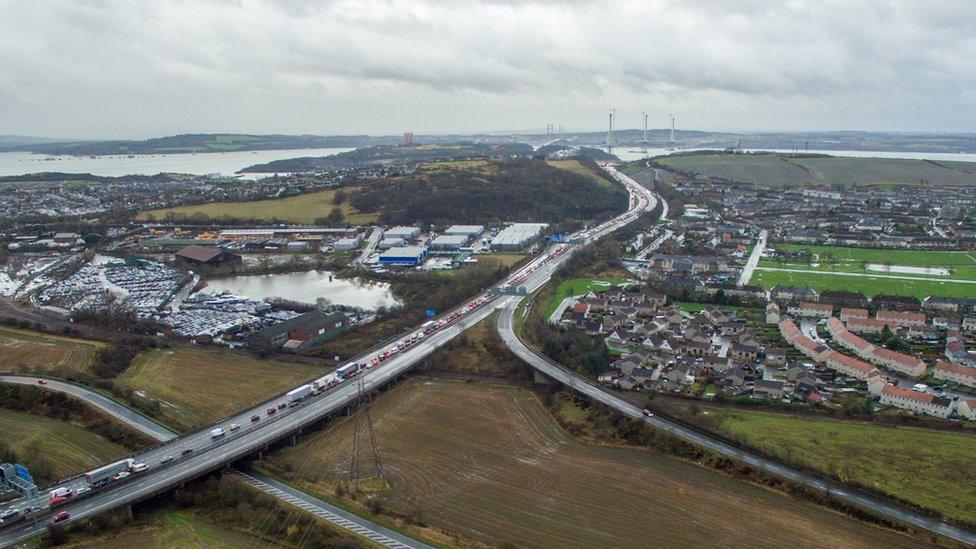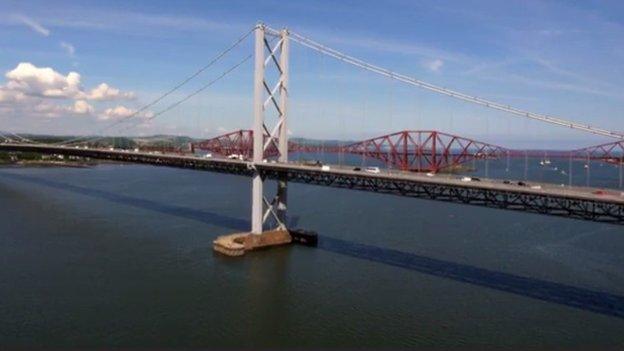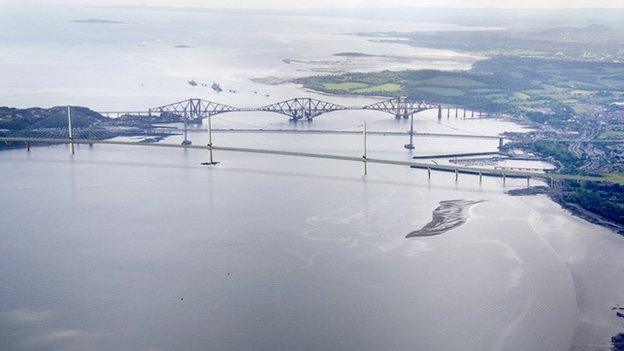The troubles of the Forth Road Bridge
- Published

The Forth Road Bridge opened to traffic 51 years ago
The Forth Road Bridge is to be closed until new year after engineers found defects in the steelwork. The 51-year-old bridge, which will be replaced by a new crossing at the end of next year, has been suffering from wear and tear for years.
Before the bridge was opened by the Queen on 4 September 1964, cars could only get across the Forth on a ferry.
So the Forth Road Bridge, which at the time was the fourth biggest suspension bridge in the world and the longest outside the United States, was welcomed as an engineering marvel.

When it was built, it was the longest suspension bridge in Europe
It transformed the journey between Edinburgh and Fife and from the north of Scotland to the south.
Traffic on the crossing grew steadily and it now carries 24 million vehicles across the Forth every year - far more than it was originally designed to handle.
But its reputation for engineering excellence has been tarnished over the years by traffic congestion and maintenance problems.
The problems that led to the bridge's imminent downgrading began in 2004 when broken steel wires and varying levels of corrosion were found in its support cables.

The closure of one carriageway led to major traffic delays on Wednesday
Amazingly, the discovery was made during the first full-scale cable inspection in the bridge's 40-year history.
At the time, bridge managers said there were no safety concerns and stressed that just 22 broken wires had been found out of 11,618 high-tensile steel wires which make up the main cable holding up the 13,800-tonne bridge.
However, further internal inspections were scheduled and an "accelerated rate of corrosion" in the main cable was found.
Inspectors said the corrosion in the cables was more likely to be found in a bridge more than 60 years old, not 40.
Acoustic monitoring
Experts recommended "dehumidification" as a way of preventing corrosion.
The proposal was to wrap the main cables in a neoprene membrane, then dry them out by pumping in dried air at various points.
The bridge authority also committed to fitting acoustic monitoring, enabling the entire length of the cables to be monitored for any further wire breaks.
However, as well as trying to save the bridge, in June 2006 the authority gave its strongest warning yet of the need to build a second crossing and the Scottish Executive, then led by Labour's Jack McConnell, started the planning process.
The £8m scheme to dry out the cables on the existing bridge began in the summer of 2007 and took two years.

The road bridge has long been in the shadow of its famous neighbour
But even when completed, its level of success would not be known for four years.
A 2008 inspection said the main suspension cables had lost about 10% of their strength but it said the cables may be deteriorating more slowly than previously feared.
A ban on HGVs using the bridge was possible but they suggested it could be a decade away.
Ministers pressed ahead, with legislation to build a new crossing being introduced in 2009 by Alex Salmond's SNP government.
Lanes of traffic
The budget was originally estimated at £4bn but ministers later announced a cut-price alternative bridge under a plan which would see the existing road bridge stay open for public transport, cyclists, pedestrians and motorbikes of less than 50cc.
It was argued that taking the bulk of traffic off the existing bridge would extend its lifespan.
The Scottish government opted for a new 2.7km-long cable-stayed bridge, with three single column towers, carrying two lanes of traffic in each direction.
The Queensferry Crossing is scheduled to open at the end of 2016.

An impression of how the Queensferry Crossing will look when it is completed in 2016
The past five years have seen an increasing effort to monitor the existing bridge's corrosion and safety levels.
In 2010, a report recommended excavations of the bridge's main cable anchorages to check their strength and in 2012, emergency repair work was carried out after damage was found on nuts attached to the main cables.
In 2013, a report into the dehumidification system concluded that corrosion problems appeared to have been resolved, greatly reducing concerns about their future safety of the suspension cables.
By April this year, 93 cable breaks had been spotted by the acoustic measuring system installed in 2006 but worryingly 24 had happened in the previous three months.
Again ministers and inspectors said the cables "were perfectly fine in terms of carrying the bridge and the traffic on the bridge".
However, further intrusive and in-depth investigations were ordered.
The latest problems with bridge are a further example of the battering the bridge has taken over the past half century and the constant monitoring which has been in place since the problems were first found.
- Published5 September 2014

- Published13 August 2015
